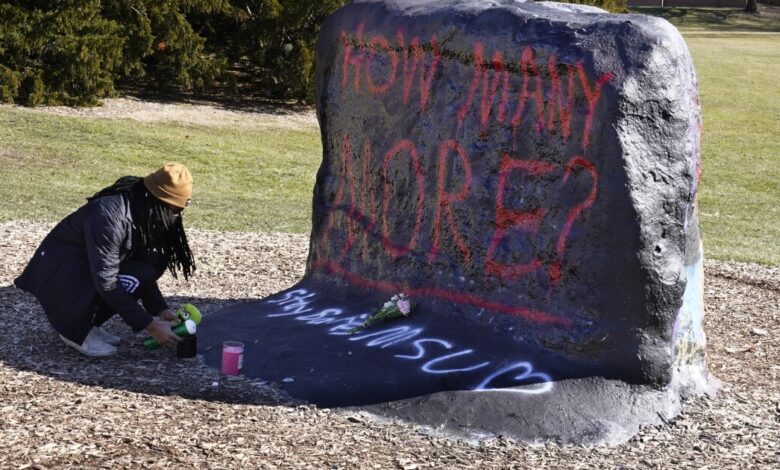How Michigan State Responded to a Mass Shooting

[ad_1]
Campus life ground to a halt at Michigan State University on Tuesday after a man shot and killed three students and injured five others before killing himself. In the hours after the shooting, which occurred on Monday around 8 p.m. local time, the university released a constant stream of information, offered support services, and canceled classes through Friday. As those on campus continue to process the aftermath of the mass shooting, some members of the campus community reflected on their role in a nation that has struggled with the realities of gun violence.
The university identified Brian Fraser, a 19-year-old sophomore; Alexandria Verner, a 20-year-old junior; and Arielle Anderson, a 19-year-old junior, as the students killed on Monday. The five injured students were in critical condition on Tuesday, and four had required surgery, officials said. Their names have yet to be released.
The police identified the shooter early Tuesday as Anthony Dwayne McRae, a 43-year-old man with no known connection to the university.
Brendan Cantwell, an associate professor of education who lives about two miles from the campus, said he knew about the shootings mere moments after they happened. “We found out within minutes of the initial shooting through email and text alerts from the emergency system. But right around the same time you started hearing sirens blaring,” Cantwell said.
On social media, students have described the hours they spent in lockdown — lights off, doors locked — staring at their phones as they waiting for more updates from the university’s police department.
Alyssa Hadley Dunn is director of teacher education and an associate professor of curriculum and instruction at the University of Connecticut’s Neag School of Education, but just a month ago she was teaching at Michigan State. Her research has focused on how inequity and trauma can affect learning, and she wrote a book, Teaching on Days After, designed for educators grappling with how to deal with tragedies or upsetting world events.

Scott Olson, Getty Images
“What they really too often remember is silence,” Dunn said of students who experience trauma. “We can’t keep doing that to our students. We can’t have their memories 30 years from now be of silence. They have to be of support.”
Dunn said professors should be willing to shift their plans and open up dialogues, even when it means going off syllabus. Trauma webs outward beyond those immediately hurt or killed, and faculty need to recognize that.
She also noted that trauma can become compounded and some of the students at Michigan State were already dealing with the aftermaths of previous shootings. One of Dunn’s previous MSU students was a survivor of the Sandy Hook Elementary School shooting, in which 26 children and staff members were killed. Another MSU student came forward as a survivor of Sandy Hook.
“The effect is not quantifiable. And it won’t all come out at once,” Dunn said.
Meanwhile, several students on campus at the same time as the active shooter were also survivors of the Oxford High School shooting, where four students were killed and seven injured about 80 miles from Michigan State.
“We have children in Michigan who are living through their second school shooting in under a year and a half,” U.S. Rep. Elissa Slotkin, Democrat of Michigan, said at a press briefing. “If this is not a wake-up call to do something, I don’t know what is.”
Along with a 48-hour hold on all campus activities and athletics, the university offered crisis counseling on Tuesday morning at a nearby community center for students, staff, faculty, and their families. Cantwell said the university had set up staging areas and was working on housing arrangements for the crowds of families and friends who descended on campus in the aftermath of the shooting. As the day went on, three different counseling locations were also added on campus, said Dan Olsen, the university’s deputy spokesperson. Dozens of community members with expertise in trauma, and Michigan State’s own personnel, provided care. Although numbers aren’t available, Olsen said that when he visited the community center where the most counselors were stationed, the auditorium was full of those seeking help.
Later this week, the university is also opening virtual “listening spaces” for students, faculty, and staff to communally process their grief, and the university’s mental-health center continued to offer appointments and virtual crisis counseling. Cantwell said that his department has been in contact with students, offering special office hours and making sure they know they aren’t alone.
Olsen said the university is working to create guidance for faculty once classes resume.
“We’re making sure that our faculty members are being as flexible as they can when it comes to course assignments and due dates and quizzes and exams as well,” Olsen said. “We’ve got faculty with expertise in this area whom we’ll be consulting as well.”
The past fall semester saw two high-profile campus shootings — one at the University of Arizona where a professor was shot and killed by a former graduate student and another at the University of Virginia where a student allegedly shot and killed three and injured two other students on the way back from a field trip. The Gun Violence Archive counted 67 mass shootings by early February in the U.S. this year. Cantwell said the tragedy wasn’t a result of any institutional negligence, but society’s.
“We have a national crisis around gun violence,” Cantwell said. “And it just puts impossible demands on organizations and on people.”
[ad_2]
Source link






